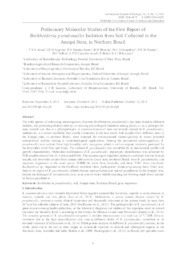Preliminary molecular studies of the first report of Burkholderia pseudomallei isolation from soil collected in the Amapá State, in Northern Brazil.
Preliminary molecular studies of the first report of Burkholderia pseudomallei isolation from soil collected in the Amapá State, in Northern Brazil.
Author(s): SOUSA, V. Y. K.; SEGOVIA, J. F. O.; MARTINS JÚNIOR, P. O.; BEZERRA, R. M.; GONÇALVES, M. C. A.; PEREIRA, S. W. M.; VALLIM, D. C.; CARVALHO-ASSEF, A. P. D.; HOFER, E.; KANZAKI, L. I. B.
Summary: The wide spectra of colonizing microorganism, likewise Burkholderia pseudomallei, has been found in different habitats, and presenting distinct activity, as exerting physiological functions among plants, or as a pathogen for man, animals and also as a phytopathogen. A common disease of men and animals caused by B. pseudomallei, melioidosis, is a severe morbidity that usually culminates in the host death. Soil samples from different areas in the Amapá state, in northern Brazil, were screened for environmental microorganisms to assess potential antimicrobial activity aiming at biotechnological applications. Among the prospected microorganisms, B. pseudomallei was isolated from high humidity soils, mangrove, which is rich in organic materials, produced by the diversified local flora and fauna. The isolated B. pseudomallei was identified by its biochemical profile and growth characteristics. Molecular confirmation of B. pseudomallei phenotypic identification was achieved by PCR amplification of the 16 S ribosomal DNA. The sequencing of amplified products confirmed that the Amapá sample, and two other isolates from human infections in Ceará state, northeast Brazil, were B. pseudomallei, and sequence alignement to the same specie, MSHR146 strain from Australia, and clone YN01 from uncultured Burkholderia sp., deposited in the GenBank, exhibited close phylogenetic relationship among them. Until now, there is no report of B. pseudomallei related disease among human and animal populations in the Amapá state, despite the finding of B. pseudomallei in it, in an area of water buffalo ranching and flowing small rivers utilized by human populations.
Publication year: 2016
Types of publication: Journal article
Unit: Embrapa Amapá
Keywords: Gene sequences, Microorganism, Microrganismo, Solo, soil
Observation
Some of Embrapa's publications are published as ePub files. To read them, use or download one of the following free software options to your computer or mobile device. Android: Google Play Books; IOS: iBooks; Windows and Linux: Calibre.
Access other publications
Access the Agricultural Research Database (BDPA) to consult Embrapa's full library collection and records.
Visit Embrapa Bookstore to purchase books and other publications sold by Embrapa.

